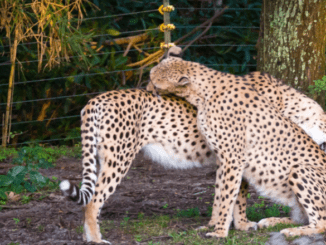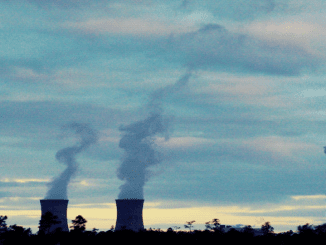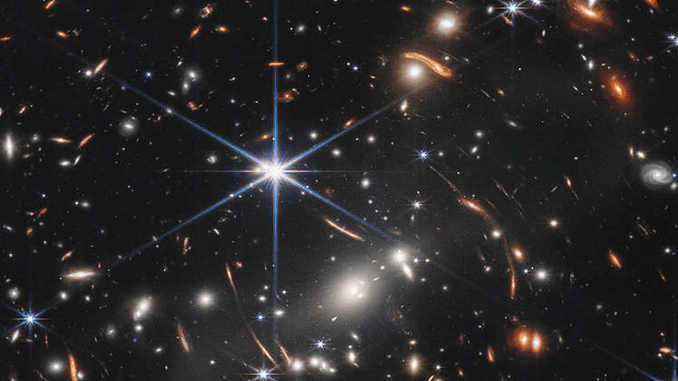
WASHINGTON, DC, July 12, 2022 (ENS) – “Today, we present humanity with a groundbreaking new view of the cosmos from the James Webb Space Telescope – a view the world has never seen before,” said NASA Administrator Bill Nelson, presenting unique images of the universe from the newly launched telescope. “These images, including the deepest view of our universe that has ever been taken, show us how Webb will help to uncover the answers to questions we don’t even yet know to ask; questions that will help us better understand our universe and humanity’s place within it.”
On July 11 President Joe Biden unveiled the first image from the new James Webb Space Telescope, the largest and most powerful space telescope ever launched. The image shows thousands of galaxies from the telescope’s current observing spot nearly one million miles (1.6 million km) from Earth.
This image, taken by Webb’s Near-Infrared Camera, NIRCam, is the deepest and sharpest infrared image of the distant universe to date. It is a composite made from images at different wavelengths, totaling 12.5 hours – achieving depths at infrared wavelengths beyond the Hubble Space Telescope’s deepest fields, which took weeks.
“These images are going to remind the world that America can do big things, and remind the American people – especially our children – that there’s nothing beyond our capacity,” said President Biden in remarks during the White House event. “We can see possibilities no one has ever seen before. We can go places no one has ever gone before.”
“The first image from the Webb Space Telescope represents a historic moment for science and technology. For astronomy and space exploration,” Biden said, “and for America and all humanity.”
Webb’s first full-color image reveals thousands of galaxies, including the faintest objects ever observed in the infrared.
The image, known as Webb’s First Deep Field, shows galaxy cluster SMACS 0723 as it appeared 4.6 billion years ago. The combined mass of this galaxy cluster acts as a gravitational lens, magnifying much more distant galaxies behind it.
“Gravitational lensing,” predicted by Albert Einstein, causes images of galaxies behind these clusters to appear magnified and distorted, like a lens distorts our view of objects behind it, achieving unprecedented magnification.
“Webb’s First Deep Field is not only the first full-color image from the James Webb Space Telescope, it’s the deepest and sharpest infrared image of the distant universe, so far. This image covers a patch of sky approximately the size of a grain of sand held at arm’s length. It’s just a tiny sliver of the vast universe,” said NASA Administrator Bill Nelson.

(Image courtesy NASA/Adriana Manrique Gutierrez)
“This mission was made possible by human ingenuity – the incredible NASA Webb team and our international partners at the European Space Agency and the Canadian Space Agency. Webb is just the start of what we can accomplish in the future when we work together for the benefit of humanity,” Nelson said.
Webb’s NIRCam has brought those distant galaxies into sharp focus – they have tiny, faint structures that have never been seen before, including star clusters. Webb’s sharp near-infrared view offers the most detailed view of the early universe to date.
Researchers will soon begin to learn more about the galaxies’ masses, ages, histories, and compositions, as the Webb telescope seeks the earliest galaxies in the universe.
The enormous cluster of galaxies was originally discovered by researchers at the University of Hawaii Institute for Astronomy, IfA, nearly 20 years ago.
“Observational astronomy has a way of leaving us in awe and speechless, but the James Webb Space Telescope, JWST, truly ushers in a new era,” said astronomer Dr. Harald Ebeling, senior faculty at IfA and principal investigator of the Massive Cluster Survey which identified the galaxy cluster.
“All the super faint, dark-red tiny dots, as well as the much brighter, strangely shaped objects in this astounding image are extremely distant galaxies that no human eye has seen before. This is the very edge of the visible Universe, brought within the reach of JWST by the gravitational amplification of SMACSJ0723 [as the cluster was labeled at IfA]. We were delighted and honored to learn that one of ‘our’ clusters was chosen to be among the very first objects to be observed with JWST,” Ebeling said.
NASA, in partnership with the European Space Agency, ESA, and the Canadian Space Agency, will release the James Webb Space Telescope’s first full-color images and spectroscopic data during a live broadcast beginning at 10:30 a.m. Eastern Time, Tuesday, July 12, from NASA’s Goddard Space Flight Center in Greenbelt, Maryland.
Released one by one, these first images from the world’s largest and most powerful space telescope will demonstrate Webb at its full power as it begins its mission to unfold the infrared universe, NASA said in a statement.
Each image will simultaneously be made available on social media, as well as on the agency’s website at: http://www.nasa.gov/webbfirstimages
“What an incredible honour for ESA and its international partners to reveal Webb’s first image from the White House,” says ESA Director General Josef Aschbacher. “Only with teamwork, dedication, and the human drive to push boundaries and explore have we arrived at this historical moment of seeing the deepest view of the early Universe to date.”
Under an international collaboration agreement, ESA provided the telescope’s launch service, using the Ariane 5 launch vehicle. Working with partners, ESA was responsible for the development and qualification of Ariane 5 adaptations for the Webb mission and for the procurement of the launch service by Arianespace.
ESA also provided the workhorse spectrograph NIRSpec and 50 percent of the mid-infrared instrument MIRI, which was designed and built by a consortium of nationally funded European Institutes, The MIRI European Consortium, in partnership with NASA’s Jet Propulsion Lab and the University of Arizona.
“ESA’s Director of Science, Günther Hasinger said, “We are ready to begin our voyage back to the early days of our Universe with this world-class observatory.”
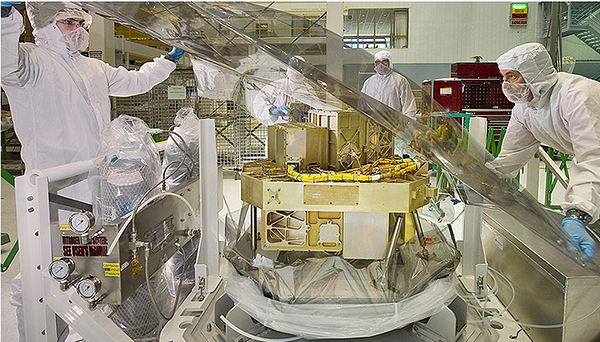
The Canadian Space Agency, CSA, contributed two elements, built by Honeywell, to the Webb Telescope – the Fine Guidance Sensor, which allows the telescope to focus on objects of interest, and the Near-Infrared Imager and Slitless Spectrograph (NIRISS), a scientific instrument that helps study many astronomical objects, from exoplanets to distant galaxies.
In exchange, Canada receives a guaranteed share of Webb’s observation time, making Canadian scientists some of the first to study data collected by the most advanced space telescope ever built.
“Scientists are thrilled that Webb is alive and as powerful as we hoped, far beyond Hubble, and that it survived all hazards to be our golden eye in the sky,” said John Mather, Webb senior project scientist at NASA’s Goddard Space Flight Center in Greenbelt, Maryland.
“What happened after the big bang? How did the expanding universe cool down and make black holes and galaxies and stars and planets and people? Astronomers see everything twice: first with pictures, and then with imagination and calculation. But there’s something out there that we’ve never imagined, and I will be as amazed as you are when we find it,” Mather said.
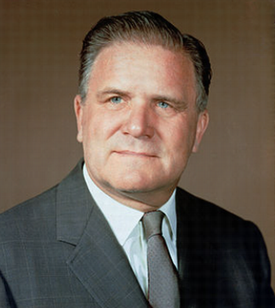
James Edwin Webb (1906-1992) served as U.S. Undersecretary of State from 1949 to 1952. He was the second appointed administrator of NASA from February 14, 1961, to October 7, 1968, from the beginning of the Kennedy administration through the end of the Johnson administration.
During his tenure, Webb oversaw each of the first crewed missions throughout NASA’s Mercury and Gemini programs until days before the launch of the first Apollo mission.
The public can join in the excitement over the new telescope and the images it’s gathering by attending one of the official Webb Space Telescope Community Events taking place across the country this summer. The list of over 280 events celebrating Webb’s first images is available online and updated frequently.
Webb, an international partnership with ESA and CSA, launched December 25, 2021 from Europe’s Spaceport in Kourou, French Guiana. After unfolding into its final form in space and successfully reaching its destination one million miles from Earth, the observatory is beginning to explore every phase of cosmic history – from within the solar system to the most distant observable galaxies in the early universe.

Webb’s first observations were selected by a group of representatives from NASA, ESA, CSA, and the Space Telescope Science Institute. They reveal the capabilities of all four of Webb’s state-of-the-art scientific instruments:
- WASP-96b (spectrum): Webb’s detailed observation of this hot, puffy planet outside our solar system reveals the clear signature of water, along with evidence of haze and clouds that previous studies of this planet did not detect. With Webb’s first detection of water in the atmosphere of an exoplanet, it will now set out to study hundreds of other systems to understand what other planetary atmospheres are made of.
- Southern Ring Nebula: This planetary nebula, an expanding cloud of gas that surrounds a dying star, is approximately 2,000 light years away. Here, Webb’s powerful infrared eyes bring a second dying star into full view for the first time. From birth to death as a planetary nebula, Webb can explore the expelling shells of dust and gas of aging stars that may one day become a new star or planet
- Stephan’s Quintet: Webb’s view of this compact group of galaxies, located in the constellation Pegasus, pierced through the shroud of dust surrounding the center of one galaxy, to reveal the velocity and composition of the gas near its supermassive black hole. Now, scientists can get a rare look, in unprecedented detail, at how interacting galaxies are triggering star formation in each other and how the gas in these galaxies is being disturbed.
- Carina Nebula: Webb’s look at the ‘Cosmic Cliffs’ in the Carina Nebula unveils the earliest, rapid phases of star formation that were previously hidden. Looking at this star-forming region in the southern constellation Carina, as well as others like it, Webb can see newly forming stars and study the gas and dust that made them.
“Absolutely thrilling!” said Mather. “The equipment is working perfectly, and nature is full of surprising beauty. Congratulations and thanks to our worldwide teams that made it possible.”
“The Webb team’s incredible success is a reflection of what NASA does best. We take dreams and turn them into reality for the benefit of humanity. I can’t wait to see the discoveries that we uncover – the team is just getting started!” NASA Administrator Nelson said.
Stay connected with the mission and share your experience with Webb’s first images on Twitter, Facebook, and Instagram with #UnfoldTheUniverse. Follow and tag these accounts:
Featured image: The first image made public from the new James Webb Space Telescope. Distant galaxies appear as bright glowing spots in the Webb telescope image, foreground stars appear bright with six-pointed diffraction spikes, owing to the shape of the telescope’s mirrors. July 11, 2022 (Photo courtesy NASA, CSA, ESA)

